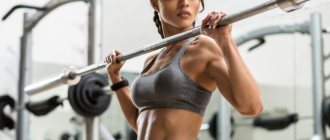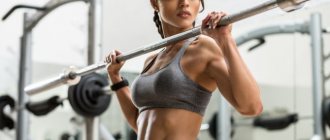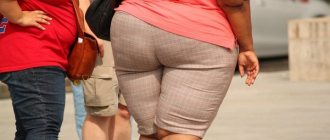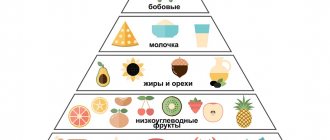An excess amount of adipose tissue in the body of any person not only makes his figure unaesthetic, but also threatens with dangerous diseases. Our article today is not about this, but about the ratio of muscle mass and fat. You've probably heard the statement that muscle is heavier than fat. This is true, but there is not such a huge difference between the volumes of fat and muscle, as is usually shown in photographs and pictures.
So, we will help you thoroughly understand what is heavier - muscles or fat, we will analyze specific numbers and tell you how voluminous fat mass is replaced by heavier muscles.
Fat or weightlifter?
You can often find a common example in the comparison of fat and muscle: a well-fed person can weigh 100 kg and not look very beautiful, and a bodybuilder who also weighs 100 kg, but has a low percentage of fat, nevertheless looks quite aesthetically pleasing. Same weight, but different shape. In the first case, the person will seem much larger in size than the second, but meanwhile they have the same weight, so what is the mystery?
Having understood the question “Which is heavier: muscles or fat in a person,” everyone can clearly understand what actions they need to take depending on their goal of building a figure. After all, only having certain knowledge in a certain matter can you competently approach solving a problem.
Human Fat Density and Muscle Density
Abdominal muscles
Muscle has a higher density than fat. It turns out that greater density occupies a smaller volume of the same weight than less density, and a person who has a lot of muscle tissue looks slimmer and prettier. And this despite the fact that they will have the same weight.
Important! It is wrong to think that a woman weighing 60 kilograms, living without exercise and being overweight, will look fatter than a pumped one.
It has been proven that fat density is 0.9 and muscle density is 1.06 grams per cubic centimeter. It turns out that the difference between them is small. It is only 15 percent and it is difficult to visually notice the difference. That is, both girls weighing 60 kilograms - one fat, the other pumped up - will look approximately the same. The only difference is that one of them has visible muscle relief.
Important! It is easier for a person who has a lot of muscles to lose weight.
It is possible to understand the truth that fat density and muscle density have little difference through experiment. You need to take meat and lard, which look the same in volume, and if you weigh them, it turns out that the meat weighs 99 grams, and the lard is only 98.
It is easier for a person who has a lot of muscles to lose weight
The following conclusions suggest themselves:
- It is not true that fat takes up ten times more space than muscle.
- Muscles grow unevenly during training. Mostly where they are being worked on. Adipose tissue is distributed evenly in particularly vulnerable areas. In men in the abdominal area, in women on the buttocks, thighs, and abdomen.
Fat or muscle - which is heavier?
Having understood this topic, you can clearly understand why such dramatic differences in weight and appearance arise. When considering the question “is muscle or fat heavier?” from the point of view of cellular structure, the clear answer is that muscles are heavier, since their cells have a higher density compared to fat cells.
Muscle cells contain protein and water, while fat cells contain only fat, or lipids. You don’t need to have any special knowledge of body structure to understand that protein and water, aka muscles, will be much denser in composition than fat.
Fat in women and men
As you know, women and men are built completely differently. Including, fat deposition in female and male bodies occurs differently.
In women, fat is usually stored on the thighs. Its function is to save energy for the lactation period and ensure the feeding of the baby. This fat is very difficult to lose. And during breastfeeding, it becomes more pliable and comes off easier.
In men, fat is deposited mostly in the abdominal area. Men generally have a much easier time losing weight than women.
It is also important that the latter are much more impressionable than men and are very sensitive to their bodies. The girl will quickly notice the extra kilogram on her body.
Men don’t worry at all about how a kilogram of fat looks on their body. Moreover, they often do not see changes in their body even by ten kilograms.
For clarity, you can go back and remember what 1 kg of fat looks like. The photo is presented above in the article.
Functions of fat deposits
Fat is not a useless phenomenon; its critical level poses a threat to health, so you need to take a responsible approach to the process of losing weight. Layers of fat protect internal organs and create an additional source of heat in cold weather, which explains the decrease in metabolism in winter as the body tries to conserve fat reserves.
Having learned the answer to the question “fat or muscle - which is heavier”, many try in every way to get rid of fat, which exceeds muscle tissue in volume, but it is worth understanding that there is a limit beyond which it is not advisable to go.
The lowest threshold for a woman’s fat level is 12%, after which problems with both appearance and feminine appearance may begin. Men can feel great with 5% body fat.
However, a high percentage of fat is harmful to the body, since the likelihood of developing diabetes increases, energy decreases, metabolism slows down, and lethargy sets in.
Why does a person need fat?
Adipose tissue has a huge range of functions. Yes, in fact, fat is not an enemy, but your best friend. It is this that will indirectly contribute to the growth of muscle mass in the future. No, this does not mean that 1 kg of fat = kg of muscle after several workouts. No! Fat will release its energy reserves for hard training, which will be aimed at growing muscle mass.
By the way, this is not the only function of adipose tissue. For example, the hormone leptin is involved in metabolism.
It is also important to take into account that it is not always useful to be “relief”. Yes, undoubtedly, for many it looks very beautiful. But the female body is not characterized by relief at all. And a lack of fat can negatively affect women's health.
Below you can see what a kilogram of fat looks like.
Why doesn't the weight change?
Due to the difference in the weight of muscle and fat, when losing weight, your weight may stay the same. In the process of sports activity, both fat is burned and muscle mass is built. Due to the fact that the proportion of body fat may be lower than the proportion of muscle, the effect of stagnant weight change can be created. In other words, two processes occurred simultaneously - fat went away and muscles increased.
Based on this, you should not attach great importance to the numbers on the scales. Visually you can see changes, a decrease in volume in certain areas, but remain at the same weight.
Many people believe that if they work out in the gym, their figure will in any case become athletic, whether they initially have fat or muscles. What is harder - burning lipids or increasing lean mass?
You need to understand that fat does not transfer to muscle. Intense exercise, of course, reduces body fat in a sense, but good results can only be achieved by limiting carbohydrates.
Pump fat into muscle?
People who are losing weight ask the question: “How to pump fat into muscles.” In fact, the answer may puzzle some. It is impossible to pump fat into muscles.
How so?
Yes, very simple. It's like turning the stomach into kidneys or the small intestine into a spleen. These are different organs and they cannot replace each other in any way. The same goes for fat and muscle. These are two different tissues that cannot transform into each other.
You can lose weight and gain muscle mass! But everything is done in stages. First, a person needs to lose excess fat, and therefore accumulate the necessary muscle mass.
Heavy bones?
An overweight person has a large proportion of body fat, while the proportion of muscle and bone tissue changes slightly. It is inappropriate to believe that weight can increase due to bone growth, since even a 10% change in the proportion of bone tissue leads to an increase in body weight by only 1-1.5 kg.
You can achieve dramatic weight gain with exercise and proper nutrition, since muscles are heavier than fat and bones. Because of this, the athlete will have large muscle mass and weight, respectively. Although, according to the classification of acceptable parameters and weight, he will belong to the overweight group, while having a low percentage of fat reserves.
Today there is a so-called bioimpedance analysis, which allows you to calculate the percentage of muscle and fat tissue in the body. Based on this, we can conclude whether a person needs to lose weight or gain weight.
When wondering whether fat or muscle is heavier, you need to consider many factors that influence weight gain.
In some cases, for example, during premenstrual syndrome in women or with heart disease, weight may increase due to fluid retention in the body. In this case, you need to consult a doctor. But still, almost everyone is overweight due to excess fat.
When understanding the question “Which is heavier: muscle or fat?”, it is important to pay attention not only to weight, but also to the distribution of fat across parts of the body. Thus, a woman, even if she is overweight, can look harmoniously built, which is due to the uniform distribution of fat deposits throughout the body.
The ratio of hips to waist volumes, taken as the norm, for women is 0.7, for men - 1.
Basic methods for determining muscle to fat ratio
In bodybuilding, there has long been a consensus that body weight itself is not an informative indicator of progress.
It is more objective to track the growth of results by changing the ratio of fat and lean muscle mass.
There are a large number of methods for determining it. At the same time, there are many more ways to find out your body fat percentage.
Each of them has its own advantages and disadvantages. But there is one pattern:
The higher the measurement accuracy (with a minimum error of 1-2%), the more complex the procedure looks. And it is even less accessible to the general public working out in the gym.
For example, one of these techniques is underwater, hydrostatic weighing. Agree, not everyone has the opportunity to pass it.
And vice versa, the simpler and more accessible the method, the greater the measurement error.
For example, caliperometry (measuring the thickness of a skin fold using a special device) – from 6 to 15% of error in measurements.
Tables of height and weight indicators
One of the simplest methods for determining approximate body fat percentage for people who do not exercise is a height-to-weight chart.
But for bodybuilding, this technique is of little use, since it does not take into account the percentage of muscle mass.
For example, in advanced athletes it consistently shows a high degree of obesity.
Formulas for body mass index and anthropometric method
There are several variants of formulas where the level of fat in the body is calculated based on the body mass index. Easy to use, but with a large error (15-20%).
Using formulas, the percentage of lean muscle mass is calculated at home.
First, the amount of fat is determined, then it is subtracted from the total weight. The resulting value is the value of muscle mass.
Again, there is a high margin of error. All formula-based methods suffer from this.
The anthropometric method is another easy-to-use method.
The circumferences of certain parts of the body (chest, waist, thigh, arm) are measured. After which this data is substituted into the formula and calculations are made.
As you may have guessed, since the method is simple and convenient, it means it is inaccurate.
Underwater weighing
Laboratory method of determination. One of the most accurate, but not suitable for most people.
The Archimedes method is used, when the density of an object is calculated by immersion in water. After which, the ratio of the fat and muscle components is determined using a special formula.
It turns out that in theory it exists, but in practice no one uses it. Perhaps in the national economy.
Bioelectrical impedance analysis, infrared method and MRI
Already from the name it is clear that the technique is associated with electricity. Electrodes are connected to the person and a low level of current is passed through.
Fat is 50% water, and muscle is 75%. Due to this, both tissues transmit current discharges differently.
A relatively accurate method for determining the percentage of muscle and fat in the body, with an error of 3 to 9%.
Infrared and MRI are also high-tech methods that give fairly good results in determining body composition.
The thickness of the fat is determined using a special sensor. Based on these data, conclusions are drawn.
The disadvantage of these methods is the high cost of the service.
Electronic scales-analyzers
Technology does not stand still, and electronic scales that can determine body composition at home already exist.
The first models had a large error and were perceived by most people as entertainment.
Modern electronic scales-analyzers quite accurately determine body composition using bioelectrical analysis using a simplified method.
Caliperometry
This is another method for determining fat levels that can be used on its own.
Using a special device, the thickness of the skin is measured in certain places. There can be from 3 to 7 such tucks (the more, the more accurate the final numbers).
The data obtained is inserted into a special formula and the percentage of fat is calculated.
Why does a person gain weight after 30?
When a person is young, he can eat a lot and with pleasure - food is easily digested, the energy obtained from it is quickly spent, and practically no body weight is gained. But somewhere in the period after 25-35 years, the human body’s need for calories changes, and physical activity sharply decreases
.
“Initially, nature set the human life expectancy at 35-40 years,” says Boytsov. “During this time, he was guaranteed to have time to produce offspring, and this is quite enough within the entire population.” Therefore, we can say that after 30 years, nature does not need a person
.
And organizing conditions for maintaining health in the future is the result of independent efforts. Despite the age-related slowdown of metabolic processes, eating behavior
usually remains the same - he eats as in his youth. As a result, additional fat deposits are formed.
Nutrition for gaining muscle mass
The first step to gaining muscle mass is for an athlete to determine his body type. There are three types in total:
- Ectomorph (thin body type);
- Mesomorph (the most comfortable type for a sculpted physique);
- Endomorph (prone to rapid weight gain).
The second step will be the nutrition plan itself. Yes, beauty requires great sacrifice and energy expenditure. Depending on what type the future “Apollo” belongs to, the athlete’s entire regime will be structured.
First of all, it is important to understand that to gain weight you will need a good appetite. Without a surplus, it will not be possible to collect housing and communal services. And given that exercises that promote muscle growth are very energy-intensive, you will have to eat a lot.
Typically, trainers advise eating 5-6 times a day. Such nutrition will allow you to quickly gain the required muscle volume. But you should be prepared for the fact that soon after such daily “stomach holidays” you will have to tighten the belt considerably. This is necessary in order to lose excess fat that accumulates along with muscle mass.
To lose weight you will have to slightly cut back on your diet. It is necessary to reduce the intake of carbohydrates and fats into the body, while simultaneously creating a calorie deficit. Such nutrition will quickly bring the percentage of fat in the body back to normal, showing everyone around the pleasant relief of a pumped-up body.










